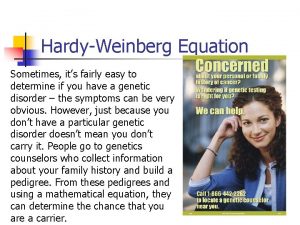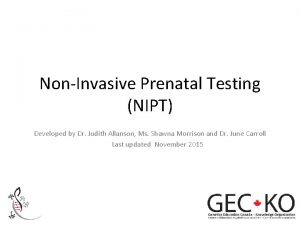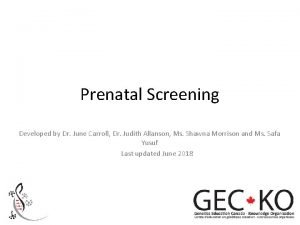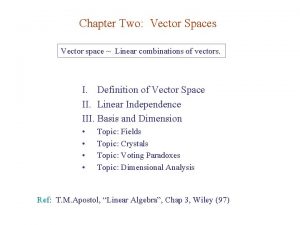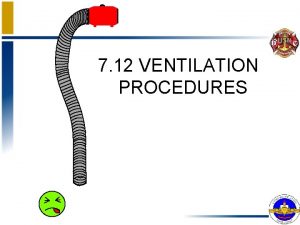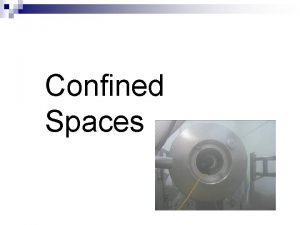The normal cell is confined to a fairly

































































































- Slides: 97




The normal cell is confined to a fairly narrow range of function and structure. • genetic programs – metabolism, – differentiation, – specialization; • by constraints of neighboring cells; • by the availability of metabolic substrates.

What if demands changes • handle normal physiologic demands, maintaining a steady state called homeostasis.

In addition to demands environment changes • Cells are constantly exposed to changes in their environment • Cells adapt to acceptable changes in their environment by modifying metabolism or growth pattern •

The main causes of disease that lead to changes in the environ ment of cells

Adaptation to severe stresses and some pathologic stimuli • The adaptive responses – hypertrophy • an increase in the sizes of individual cells, – hyperplasia • increase in the number of cells, – atrophy • decrease in the size and function of cells. – Metaplasia change in the differentiation of cell s

2. 3 Changes in growth of cells.

Adaptation, reversible injury, and cell death can be considered a spectrum • limits of adaptive response to a stimulus are exceeded, or • the cell is exposed to a more injurious agent or severe stress, • a sequence of events follows that leads to cell injury. • Cell injury is reversible up to a certain point, • the stimulus persists or is severe enough from the beginning, the cell reaches a "point of no return" and suffers irreversible cell injury and ultimately cell death.

Example • For instance, in response to increased hemodynamic loads, the heart muscle first becomes enlarged, a form of adaptation. If the blood supply to the myocardium is insufficient to cope with the demand, the muscle becomes reversibly injured and finally undergoes cell death

Cell death, • is one of the most crucial events in the evolution of disease of any tissue or organ. • There are two principal patterns of cell death, necrosis and apoptosis.

Necrosis is the type of cell death that occurs after such abnormal stresses as ischemia and chemical injury, and it is always pathologic.

Apoptosis occurs when a cell dies through activation of an internally controlled suicide program. It is designed to eliminate unwanted cells during embryogenesis and in various physiologic processes, such as involution of hormoneresponsive tissues upon withdrawal of the hormone.

Stages in the cellular response to stress and injurious stimuli.

Summary of tissue response to environmental change. Adaptive responses allow cells to survive in the face of a change in the cellular environment. Failure to adapt is associated with cell damage or cell death.

subcellular alterations. • Stresses of different types may induce other changes • Cells that are exposed to sublethal or chronic stimuli cells may show a variety of subcellular alterations. – Subcellular alterations may operate through Metabolic derangements in cells – may be associated with intracellular accumulations of a number of substances, including proteins, lipids, and carbohydrates. – Calcium is often deposited at sites of cell death, resulting in pathologic calcification. • cell aging is also accompanied by characteristic morphologic and functional changes.

Nature and Severity of Injurious Stimulus Cellular Response Table 1 -1. Cellular Responses to Injury Altered physiologic stimuli: Cellular adaptations: • Increased demand, increased trophic stimulation (e. g. growth factors, hormones) • Hyperplasia, hypertrophy • Decreased nutrients, stimulation • Atrophy • Chronic irritation (chemical or physical) • Metaplasia Reduced oxygen supply; chemical injury; microbial infection Cell injury: • Acute and self-limited • Acute reversible injury • Progessive and severe (including DNA damage) • Irreversible injury → cell death Necrosis Apoptosis • Mild chronic injury • Subcellular alterations in various organelles Metabolic alterations, genetic or acquired Intracellular accumulations; calcifications Prolonged life span with cumulative sublethal injury Cellular aging

The relationships between normal, adapted, reversibly injured, and dead myocardial cells. The cellular adaptation depicted here is hypertrophy, and the type of cell death is ischemic necrosis. In reversibly injured myocardium, generally effects are only functional, without any readily apparent gross or even microscopic changes.

Hyperplasia • Hyperplasia is an increase in the number of cells in an organ or tissue, usually resulting • in increased volume of the organ or tissue. • Hyperplasia takes place if the cellular population is capable of synthesizing DNA, thus permitting mitotic division;

Hyperplasia • hyperplasia and hypertrophy are two distinct processes, • frequently both occur together, • and they may be triggered by the same external stimulus. • For instance, hormone-induced growth in the uterus involves both increased numbers of smooth muscle and epithelial cells and the enlargement of these cells. • by contrast, hypertrophy involves cell enlargement without cell division.

Hyperplasia can be physiologic or pathologic.

Physiologic Hyperplasia • (1) hormonal hyperplasia, which increases the functional capacity of a tissue when needed, • (2) compensatory hyperplasia, which increases tissue mass after damage or partial resection.

Hormonal hyperplasia • is best exemplified by the proliferation of the glandular epithelium of the female breast at puberty and during pregnancy and the physiologic hyperplasia that occurs in the pregnant uterus.

compensatory hyperplasia • remaining tissue grows to make up for partial tissue loss • Live hyperplasia • after unilateral nephrectomy,

Mechanisms of Hyperplasia. • increased local production of growth factors, • increased levels of growth factor receptors on the responding cells, • Turning on many cellular genes, including genes encoding growth factors, receptors for growth factors, and cell cycle regulators, • In hormonal hyperplasia, the hormones may themselves act as growth factors and trigger the transcription of various cellular genes.

Pathologic Hyperplasia • Endometrial hyperplasia is an example of abnormal hormone-induced hyperplasia. • This form of hyperplasia is a common cause of abnormal menstrual bleeding.

Pathologic Hyperplasia • Benign prostatic hyperplasia is another common example of pathologic hyperplasia induced by responses to hormones, androgens. • Although these forms of hyperplasia are abnormal, the process remains controlled, because the hyperplasia regresses if the hormonal stimulation is eliminated. • Responsiveness to normal regulatory control mechanisms that distinguishes benign pathologic hyperplasia's from cancer, in which the growth control mechanisms become defective. • Pathologic hyperplasia, however, constitutes a fertile soil in which cancerous proliferation may eventually arise. • Thus, patients with hyperplasia of the endometrium are at increased risk for developing endometrial cancer

Pathologic Hyperplasia • Hyperplasia is also an important response of connective tissue cells in wound healing, in which proliferating fibro-blasts and blood vessels aid in repair • Under these circumstances, growth factors are responsible for the hyperplasia.




HYPERTROPHY • an increase in the size of cells, – resulting in an increase in the size of the organ. • the hypertrophied organ has no new cells, just larger cells. • The increased size of the cells is due not to cellular swelling but to the synthesis of more structural components. • cells capable of division may respond to stress by undergoing both hyperplasia and hypertrophy, • whereas in nondividing cells (e. g. , myocardial fibers), hypertrophy occurs.

Hypertrophy can be physiologic or pathologic

Physiological Hypertrophy • is caused by increased functional demand or • by specific hormonal stimulation. – The striated muscle cells in both the heart and the skeletal muscles are capable of hypertrophy, – they cannot adequately adapt to increased metabolic demands by mitotic division and production of more cells to share the work.

Hypertrophy • The most common stimulus for hypertrophy of muscle is increased workload. • For example, the bulging muscles of bodybuilders. • chronic hemodynamic overload, resulting from either hypertension or faulty valves.

Hypertrophy • The massive physiologic growth of the uterus during pregnancy is a good example of hormone -induced increase in the size of an organ that results from both hypertrophy and hyperplasia • The cellular hypertrophy is stimulated by estrogenic hormones acting on smooth muscle estrogen receptors, eventually resulting in increased synthesis of smooth muscle proteins and an increase in cell size

Physiologic hypertrophy of the uterus during pregnancy. A, Gross appearance of a normal uterus (right) and a gravid uterus (removed for postpartum bleeding) (left). B, Small spindle-shaped uterine smooth muscle cells from a normal uterus (left) compared with large plump cells in gravid uterus (right).

Hypertrophy of cardiac muscle in response to valve disease

The upper macroscopic specimen (a)demonstrates the normal thickness of the left ventricular wall for comparison with the greatly thickened wall in the lower specimen, taken from a heart in which severe narrowing of the aortic valve caused resistance to systolic ventricular emptying. The increased mass of the left ventricle is due to enlargement of cardiac muscle cells as a result of hypertrophy. This can be seen by comparing the diameter of fibres from the normal heart (b) with those from the diseased heart (c). } Note that the size of nuclei in the hypertrophied cardiac muscle is also increased; it has been found that such nuclei are frequently polyploid (i. e. contain several times the normal quantity of DNA).

Histology of cardiac muscle from a normal heart


Histology of cardiac muscle from a hypertrop hied heart


Hyperplasia and hypertrophy of myometrium in pregnancy. On the left is a normal uterus showing the normal mass of smooth muscle in its wall. On the right is a uterus from a recently pregnant woman, in which the striking increase in mass of smooth muscle is evident. At a cellular level this is due to both hyperplasia and hypertrophy of uterine smooth muscle. +} }}






Mechanisms of Hypertrophy. • induction of a number of genes, which in turn stimulate synthesis of numerous cellular proteins

ATROPHY • Shrinkage in the size of the cell by loss of cell substance is known as atrophy. • When a sufficient number of cells are involved, the entire tissue or organ diminishes in size, or becomes atrophic. •

Atrophy can be physiologic or pathologic.

Physiologic atrophy • The uterus decreases in size shortly after parturition,

Pathologic atrophy • depends on the underlying cause and can be local or generalized.

The common causes of atrophy • Decreased workload (atrophy of disuse). – When a broken limb is immobilized in a plaster cast or – when a patient is restricted to complete bed rest, • The initial rapid decrease in cell size is reversible once activity is resumed. • With more prolonged disuse, skeletal muscle fibers decrease in number as well as in size; • this atrophy can be accompanied by increased bone resorption, leading to osteoporosis of disuse.

The common causes of atrophy • Loss of innervation (denervation atrophy). – Normal function of skeletal muscle is dependent on its nerve supply. – Damage to the nerves leads to rapid atrophy of the muscle fibers supplied by those nerves • Diminished blood supply. – A decrease in blood supply (ischemia) to a tissue as a result of arterial occlusive disease results in atrophy of tissue owing to progressive cell loss. – In late adult life, the brain undergoes progressive atrophy, presumably as atherosclerosis narrows its blood supply

The common causes of atrophy • Loss of endocrine stimulation. – Many endocrine glands, the breast, and the reproductive organs are dependent on endocrine stimulation for normal metabolism and function. – The loss of estrogen stimulation after menopause results in physiologic atrophy of the endometrium, vaginal epithelium, and breast.

The common causes of atrophy • Pressure. • Tissue compression for any length of time can cause atrophy. • An enlarging benign tumor can cause atrophy in the surrounding compressed tissues. – Atrophy in this setting is probably the result of ischemic changes caused by compromise of the blood supply to those tissues by the expanding mass. • Inadequate nutrition. • .

, Atrophy of the brain in an 82 -year-old male with atherosclerotic disease. Atrophy of the brain is due to aging and reduced blood supply. The meninges have been stripped. B, Normal brain of a 36 -year-old male. Note that loss of brain substance narrows the gyri and widens the sulci.







• Atrophy of the adrenal gland. • Specimen (b) is a slice of normal gland, in which yellow cortex can be distinguished from the small amount of grey medulla. • The slice in (a) is from a patient who had surgical ablation of the pituitary gland, leading to lack of ACTH. • This has resulted in reduction in the size of the adrenal gland, specifically affecting the cortex.

A, Schematic diagram of columnar to squamous metaplasia. B,

METAPLASIA • Metaplasia is a reversible change in which one adult cell type (epithelial or mesenchymal) is replaced by another adult cell type. • It may represent an adaptive substitution of cells that are sensitive to stress by cell types better able to withstand the adverse environment.

METAPLASIA • Stones in the excretory ducts of the salivary glands, pancreas, or bile ducts may cause replacement of the normal secretory columnar epithelium by nonfunctioning stratified squamous epithelium • A deficiency of vitamin A (retinoic acid) induces

METAPLASIA • The most common epithelial metaplasia is columnar to squamous as occurs in the respiratory tract in response to chronic irritation. • In the habitual cigarette smoker, the normal ciliated columnar epithelial cells of the trachea and bronchi are often replaced focally or widely by stratified squamous epithelial cells.

Metaplasia • . • Although the metaplastic squamous cells in the respiratory tract, for example, are capable of surviving, an important protective mechanism-mucus secretion-is lost. • Thus, epithelial metaplasia is a two-edged sword and, in most circumstances, represents an undesirable change

Metaplasia • the influences that predispose to metaplasia, if persistent, may induce malignant transformation in metaplastic epithelium. • Thus, the common form of cancer in the respiratory tract is composed of squamous cells, which arise in areas of metaplasia of the normal columnar epithelium into squamous epithelium.

METAPLASIA • Metaplasia from squamous to columnar type may also occur, as in Barrett esophagus, in which the esophageal squamous epithelium is replaced by intestinal-like columnar cells under the influence of refluxed gastric acid • Cancers may arise in these areas, and these are typically glandular (adeno)carcinomas

METAPLASIA • Connective tissue metaplasia is the formation of cartilage, bone, or adipose tissue (mesenchymal tissues) in tissues that normally do not contain these elements. • For example, bone formation in muscle, designated myositis ossificans, occasionally occurs after bone fracture. • This type of metaplasia is less clearly seen as an adaptive response.

Mechanisms of Metaplasia. • Metaplasia does not result from a change in the phenotype of a differentiated cell type; • instead it is the result of a reprogramming of stem cells that are known to exist in normal tissues, or of undifferentiated mesenchymal cells present in connective tissue. • In a metaplastic change, these precursor cells differentiate along a new pathway

Metaplastic transformation of esophageal stratified squamous epithelium (left) to mature columnar epithelium (so-called Barrett metaplasia











Summary of tissue response to environmental change. Adaptive responses allow cells to survive in the face of a change in the cellular environment. Failure to adapt is associated with cell damage or cell death.





Hypertrophy of skeletal muscle in response } to exercise. Hypertrophy in the absence of hyperplasia is typically seen in muscle where the stimulus is an increased demand for work. Taken at the same magnification, (a) shows muscle fibres in transverse section from the soleus muscle of a normal 50 -year-old male and (b) shows fibres from the same muscle in a veteran marathon runner. Note the dramatic increase in the size of the fibres in response to the demands of marathon running.




• Atrophy of skeletal muscle with • denervation. • Micrograph (a)shows normal skeletal muscle fibres. In micrograph (b) damage to many of the axons in the main nerve supplying the muscle has caused atrophy of fibres, • Fibres are small and angulated.
 Fairly satisfactory grade
Fairly satisfactory grade How can governments ensure citizens are treated fairly
How can governments ensure citizens are treated fairly Fairlytales
Fairlytales The fairly intelligent fly
The fairly intelligent fly Match each character with his perspective
Match each character with his perspective Tcf outcomes 1 6
Tcf outcomes 1 6 It's fairly easy
It's fairly easy Communicate information fairly and objectively
Communicate information fairly and objectively Macbeth's moral decline
Macbeth's moral decline Confined placental mosaicism
Confined placental mosaicism Unconfined aquifer definition
Unconfined aquifer definition Confined space gas limits
Confined space gas limits Aa 1926
Aa 1926 Confined space meaning
Confined space meaning Osha 1910 confined space
Osha 1910 confined space Confined space presentation
Confined space presentation Saba confined space
Saba confined space Saba confined space
Saba confined space Confined space gas limits
Confined space gas limits Entry supervisor
Entry supervisor 1910 146
1910 146 Confined space gas limits
Confined space gas limits Confined space 1910
Confined space 1910 1910-146
1910-146 Osha confined space training powerpoint
Osha confined space training powerpoint Suspended particulate matter
Suspended particulate matter Dr june carroll
Dr june carroll Confined spaces
Confined spaces Confined space rescue equipment
Confined space rescue equipment Confined space refresher
Confined space refresher Confined space rescue equipment
Confined space rescue equipment How to determine subspace of vector space
How to determine subspace of vector space Confined space rescue equipment
Confined space rescue equipment Confined space ventilation calculation
Confined space ventilation calculation Obtain authorization before entering a confined space
Obtain authorization before entering a confined space Agricultural confined space training
Agricultural confined space training Confined space rescue powerpoint presentation
Confined space rescue powerpoint presentation Ventilation worksheet
Ventilation worksheet Confined spaces
Confined spaces Confined spaces
Confined spaces Confined space training quiz
Confined space training quiz Confined space refresher training
Confined space refresher training Confined space classification
Confined space classification Allude clairvoyant conclusive
Allude clairvoyant conclusive Confined space rescue equipment
Confined space rescue equipment Confined space definition bc
Confined space definition bc 1910 confined space
1910 confined space Hymen
Hymen Hình ảnh bộ gõ cơ thể búng tay
Hình ảnh bộ gõ cơ thể búng tay Lp html
Lp html Bổ thể
Bổ thể Tỉ lệ cơ thể trẻ em
Tỉ lệ cơ thể trẻ em Gấu đi như thế nào
Gấu đi như thế nào Thang điểm glasgow
Thang điểm glasgow Chúa sống lại
Chúa sống lại Các môn thể thao bắt đầu bằng tiếng đua
Các môn thể thao bắt đầu bằng tiếng đua Thế nào là hệ số cao nhất
Thế nào là hệ số cao nhất Các châu lục và đại dương trên thế giới
Các châu lục và đại dương trên thế giới Công thức tính độ biến thiên đông lượng
Công thức tính độ biến thiên đông lượng Trời xanh đây là của chúng ta thể thơ
Trời xanh đây là của chúng ta thể thơ Mật thư anh em như thể tay chân
Mật thư anh em như thể tay chân Phép trừ bù
Phép trừ bù Phản ứng thế ankan
Phản ứng thế ankan Các châu lục và đại dương trên thế giới
Các châu lục và đại dương trên thế giới Thể thơ truyền thống
Thể thơ truyền thống Quá trình desamine hóa có thể tạo ra
Quá trình desamine hóa có thể tạo ra Một số thể thơ truyền thống
Một số thể thơ truyền thống Cái miệng nó xinh thế chỉ nói điều hay thôi
Cái miệng nó xinh thế chỉ nói điều hay thôi Vẽ hình chiếu vuông góc của vật thể sau
Vẽ hình chiếu vuông góc của vật thể sau Biện pháp chống mỏi cơ
Biện pháp chống mỏi cơ đặc điểm cơ thể của người tối cổ
đặc điểm cơ thể của người tối cổ Thế nào là giọng cùng tên
Thế nào là giọng cùng tên Vẽ hình chiếu đứng bằng cạnh của vật thể
Vẽ hình chiếu đứng bằng cạnh của vật thể Phối cảnh
Phối cảnh Thẻ vin
Thẻ vin đại từ thay thế
đại từ thay thế điện thế nghỉ
điện thế nghỉ Tư thế ngồi viết
Tư thế ngồi viết Diễn thế sinh thái là
Diễn thế sinh thái là Dot
Dot Số nguyên tố là số gì
Số nguyên tố là số gì Tư thế ngồi viết
Tư thế ngồi viết Lời thề hippocrates
Lời thề hippocrates Thiếu nhi thế giới liên hoan
Thiếu nhi thế giới liên hoan ưu thế lai là gì
ưu thế lai là gì Hổ đẻ mỗi lứa mấy con
Hổ đẻ mỗi lứa mấy con Sự nuôi và dạy con của hươu
Sự nuôi và dạy con của hươu Sơ đồ cơ thể người
Sơ đồ cơ thể người Từ ngữ thể hiện lòng nhân hậu
Từ ngữ thể hiện lòng nhân hậu Thế nào là mạng điện lắp đặt kiểu nổi
Thế nào là mạng điện lắp đặt kiểu nổi Spongebob cell analogy
Spongebob cell analogy Difference between mercury cell and diaphragm cell
Difference between mercury cell and diaphragm cell Site:slidetodoc.com
Site:slidetodoc.com Prokaryotic
Prokaryotic Plant vs animal cells organelles
Plant vs animal cells organelles What is a half reaction
What is a half reaction Dry cell vs wet cell
Dry cell vs wet cell Animal cells and plant cells venn diagram
Animal cells and plant cells venn diagram






